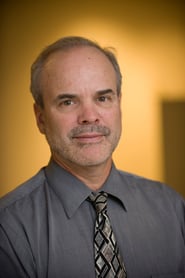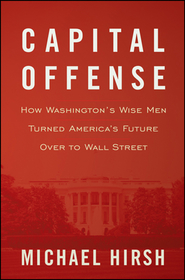Michael Hirsh, the longtime economics correspondent for Newsweek , now serves as chief correspondent for National Journal. In his new book, Capital Offense: How Washington’s Wise Men Turned America’s Future Over to Wall Street, and a current feature he traces the economic crisis of 2008 back to its roots in Washington economic policy from the era after Reagan, arguing that the policy process in Washington was captured by the financial industry. I put six questions to Michael about his book:
1. You introduce the issue of Washington’s failed economic stewardship by profiling Brooksley Born. Explain what role she played and why you consider it symptomatic.

Brooksley Born was a brilliant Stanford-educated lawyer who was short-listed as Bill Clinton’s attorney general choice in 1993. She didn’t get that job but as a consolation prize was named head of an obscure agency, the Commodity Futures Trading Commission (cftc). From that perch Born saw, earlier than most—this was the late 1990s—that Wall Street was using complex over-the-counter (otc) derivatives to hoodwink unsuspecting customers. Big and trusted firms like Merrill Lynch were beginning to sell vastly complex securities that even sophisticated companies like Procter and Gamble couldn’t understand. Hundreds of millions of dollars were being lost on such deals. Born saw, in other words, the earlier iterations of the subprime collateralized debt obligations (cdos)–this habit of taking dubious assets and repackaging them as better assets–that were later blamed for the financial catastrophe.
So Born became a Cassandra about the dangers of unmonitored otc derivatives. Her story is telling because of the utter contempt with which the best and brightest of Washington–Robert Rubin, Larry Summers, Alan Greenspan–treated her. She was railroaded out of the cftc, ignored, mocked, and lampooned. As I sum it up in the book, Born failed because she was taking on the impossible: she was trying to turn back the tide of an entire era. The idea she was trying to fight was free-market fundamentalism. The very idea of government regulation and oversight became a kind of heresy during this epoch.
2. What about Joseph Stiglitz? He was universally viewed as a leading economic theorist of the age, and he was sounding notes of alarm that proved extremely prescient.
Stiglitz is one of the key figures in my narrative. He was a Midwestern genius who grew up in Gary, Indiana—one of the grittiest industrial cities in the United States—and had begun to ask questions about why markets sometimes didn’t work well from the time he was a small boy. Like Keynes, who was ignored when he warned after World War I that the draconian peace imposed on Germany would lead to disaster, Stiglitz stood almost alone against the “Washington Consensus” lorded over by Rubin, Greenspan, and Summers.
Despite his Nobel Prize and his worldwide fame, Stiglitz too was marginalized, ignored, and eventually railroaded out of Washington. He was invited into the Clinton administration, but not the Obama administration. After the financial disaster of 2008, Stiglitz was full of ideas about reform. While the Obama administration tried to induce the banks to lend more and develop workout programs for underwater borrowers, Stiglitz wanted to give mortgagees the same kinds of rights that distressed corporations get under Chapter 11 of the bankruptcy code, which would allow a judge to reduce the debt subject to a mortgage in the same way he can give creditors a “haircut” in a Chapter 11 proceeding. The financial industry hated the idea, but it was wealthy enough now to endure it. Everyone tut-tutted over the “moral hazard” of forgiving homeowner debt on bad mortgages—it would make mortgagees lazy and careless in the future, critics say. (The “Tea Party” movement was launched by cnbc reporter Rick Santelli’s rant about this.) Never mind that the moral hazard of bailing out the banks was likely far worse.
Stiglitz went further than most others in talking about a complete rethinking of pay and bonuses, tossing out the performance-based incentives that had only rewarded short-term sales and grossly twisted behavior. He even urged a new look at why credit-card companies charged small businesses so much—1 to 2 percent for every transaction—when modern technology permitted an efficient, low-cost electronic payment mechanism that should cost pennies per transaction. It was yet another example of the way Wall Street seemed to have the upper hand over every part of the real economy.
3. You highlight Alan Greenspan’s involvement with Ayn Rand and her thinking. Greenspan is famous for being laconic and carefully measured. What evidence can you offer that Rand’s thinking influenced his economic policy advice and particularly his guidance of the Federal Reserve Bank?
Greenspan was, as I say in the book, “a stealth ideologue.” He was a soft-spoken gentleman, the opposite of the image of the ideological ranter that so defines the debate today. But Greenspan did more than any other single person to shape the free-market Zeitgeist in practice.
His ideology was defined in negative terms—in a mulish resistance to any policy that smacked of government regulation, and in a belief that the U.S. economy always returned on its own to equilibrium. Much of this reflected the influence of Ayn Rand, whom Greenspan invited to his first swearing-in as chairman of Gerald Ford’s Council of Economic Advisors. I interviewed most of the last living members of the old Ayn Rand circle from the ‘50s, and they all spoke about the remarkable relationship between Greenspan and Rand.
Greenspan himself testified to her influence. “When I met Ayn Rand, I was a free enterpriser in the Adam Smith sense, impressed with the theoretical structure and efficiency of markets,” he once told my magazine, Newsweek. “What she did was to make me see that capitalism is not only efficient and practical, but moral.”
That code became the moral framework for his life and business. In 1953, Greenspan had opened a consulting firm, Townsend-Greenspan, that specialized in detailed studies of industrial data. Yet even there the Randian ideas appeared as a stricture against regulation or even recommending it. Kathryn Eickhoff ran the firm for him after he went to Washington and was another in a series of erstwhile Greenspan girlfriends. “Ayn Rand’s philosophical theories were overriding,” she told me.
These Randian ideas were all but undetectable in the things Greenspan said during most of his time in Washington, first as chairman of the Council of Economic Advisors and then as Fed chairman. But they were always there.
4. You focus on a failure of regulation, particularly of arcane markets in derivatives and reinsurance, as the basis for the economic trauma of 2008. Republicans focus elsewhere, particularly on the relaxed lending to the subprime real-estate market and the role played by unions in negotiating government employment contracts. Do they score any points with these arguments?
The government role in fostering the subprime bubble was a factor, but only that. Many on the right still contend that Fannie Mae and Freddie Mac, the giant, quasi-governmental lending institutions, were the real cause of the 2008 financial crash. Unfortunately for the blame-the-government crowd, the facts don’t bear out their conclusions. Yes, Fannie and Freddie are government sponsored, but they’re run by shareholders looking for a substantial return. And the prime force that was driving them and just about everyone else in the world to take risks was Wall Street, which kept looking for higher returns. Indeed, Fannie and Freddie didn’t go nearly as far out on a limb as other lenders, and they hadn’t actually created derivative products themselves.
Beyond that, the seeds of the financial crash of 2008 were planted decades before the subprime securitization market took off.
5. After the departure of Eliot Spitzer, no serious prosecution of a Wall Street baron appears to have been mounted—even in the face of the 2008 collapse. Has the Obama Administration failed to revive criminal accountability for high-stakes financial fraud and mismanagement?

Almost totally. Criminal and civil investigations in the wake of the financial crisis have not, in general, fared very well. Last year, the sec and the Justice Department, lacking evidence of fraud, declined to file charges against Joseph Cassano, the former aig financial products chief whom the writer Michael Lewis once called “the man who crashed the world.” (Cassano, in testimony to the Financial Crisis Inquiry Commission on June 30, insisted that he had been “prudent” in selling billions of dollars in credit-default swaps, despite the government’s $130 billion bailout of aig.) Though it is clear by now that Wall Street played a giant confidence game with the world, disguising bad and often fraudulent mortgages as highly rated securities, selling scam derivatives by the trillions of dollars, it is also clear that there will be no spate of prosecutions as there was after the S&L crisis, or during the insider-trading scandals of the ‘80s, when Michael Milken and Ivan Boesky were convicted in high-profile trials and served as a warning to others.
6. What did Obama fail to fix in the financial system and the economy?
The president proudly called the new Dodd-Frank law “the toughest financial reform since the one we created in the aftermath of the Great Depression.” What Obama left unsaid was that his administration had argued against many of the toughest amendments in the bill. And Wall Street, in the end, didn’t complain about it all that much. The biggest firms knew that much of what their powerful lobbyists had failed to block or water down in the bill could be taken care of later on. They’d still be able to influence the vast set of rules on capital, leverage, and other financial issues that would be written by regulators. Led by Summers and Geithner, Obama’s economic team resisted almost every structural change to Wall Street—in particular, Volcker’s plan (initially) and Arkansas Senator Blanche Lincoln’s idea to bar banks from swaps trading. The administration’s program for getting underwater mortgage holders out of trouble was far too modest—and even that is in danger of obliteration by the new Republican-led House.
Obama’s aides claimed they were only making necessary compromises, placating the Republicans and centrist Democrats they needed to pass the law. And they did stand firm on creating a strong Consumer Financial Protection Bureau. But by midsummer of 2010, the Volcker rule that Obama finally backed was so full of exemptions—allowing banks to invest substantially in hedge and equity funds—that even Volcker expressed dismay. The new law effectively anointed the existing banking elite, possibly making them even more powerful. The major firms got to keep the biggest part of their derivatives business in interest-rate and foreign-exchange swaps. (JPMorgan, Goldman Sachs, Citigroup, Bank of America, and Morgan Stanley control more than 95 percent, or about $200 trillion worth, of that market.)
The same banks may end up controlling or at least dominating the clearinghouses they are being pressed to trade on as well. New capital charges, meanwhile, have created barriers to entry for new firms. This consolidation of the elites has in turn kept alive the “too big to fail” problem.
Some regulators also worry that in the long run the system could grow even riskier than it was leading up to 2008. That’s because the resurrected giants of Wall Street are getting even more global in their revenue base—Citigroup ceo Vikram Pandit has taken to calling his company “America’s global bank,” and he’s getting some 70 percent of his revenues now from Latin America and Asia. But the much-touted “resolution authority” in the new Dodd-Frank law, which will theoretically allow Washington regulators to liquidate a failing firm, is not very practical internationally. So the U.S. government has become the guarantor of last resort for global banks over which it has even less oversight than before.


